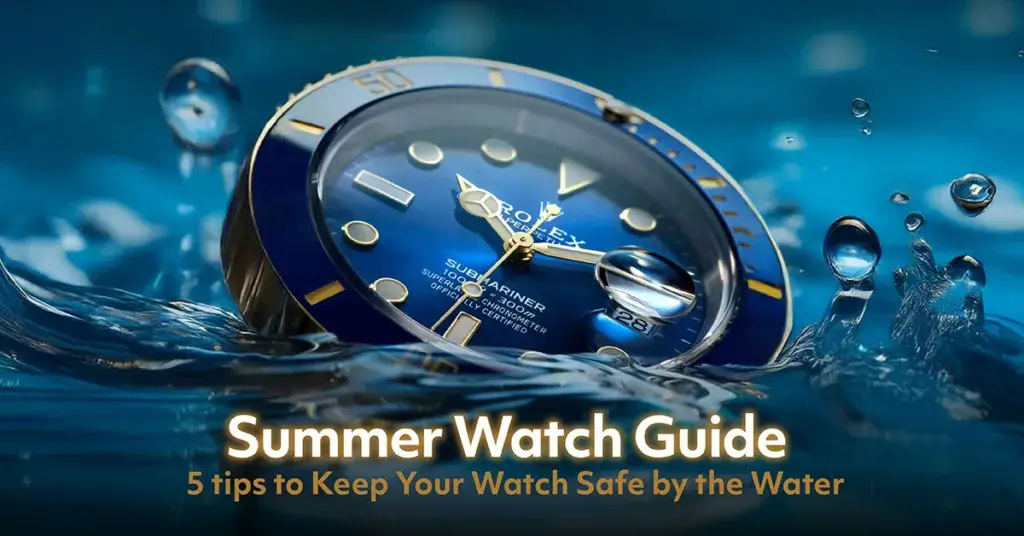As the sun ascends and aquatic adventures beckon, from gasket fatigue to condensation and corrosion, it rises sharply. Even rugged models can suffer from water intrusion if exposed to sudden temperature shifts, chemicals, or poor aftercare. Protect your investment and maintain peak performance with our 5 Summer Watch Guide.

1. Understanding Water Resistance: Beyond the Numbers

The water resistance of a watch is often indicated by metrics such as meters (M), atmospheres (ATM), or bars (BAR). While these figures provide a general indication, their practical implications vary significantly. For instance, a watch rated at 3 ATM/3 BAR/30 meters is suitable only for daily splashes and rain, not for swimming. A 5 ATM/5 BAR/50-meter rating permits short swims in shallow water, but is unsuitable for diving or snorkeling. For more vigorous activities like swimming and snorkeling, a minimum of 10 ATM/10 BAR/100 meters is recommended. Watches designed for high-impact water sports and professional diving typically boast ratings of 20 ATM/20 BAR/200 meters or higher. Always align your watch’s water resistance rating with the intensity of your planned aquatic endeavors.
2. Always Tighten the Crown

Many high-performance waterproof watches feature screw-down crowns and casebacks, which are integral to their water-resistant capabilities. These mechanisms create a tighter seal, significantly reducing the risk of water penetration. Prior to any water exposure, meticulously ensure that the crown is fully screwed down and the caseback is securely fastened. Neglecting this simple step can compromise the watch’s water resistance, leading to irreparable damage.
3. Rinse Off After The Sea

Both saltwater and chlorinated pool water pose significant threats to your watch. The corrosive properties of salt can degrade metal components and gaskets over time, while the chemicals in pool water can similarly affect seals and finishes. Even if your watch is rated for water resistance, prolonged exposure to these environments should be minimized. The cumulative effect of these elements can gradually undermine the watch’s protective barriers.
Following any contact with saltwater or chlorinated pool water, a thorough rinse with clean, fresh water is imperative. This simple yet vital step helps to neutralize the corrosive effects of salt and chemicals. After rinsing, gently dry the watch with a soft, lint-free cloth. Avoid using soaps or harsh detergents, as these can strip away protective coatings or damage the delicate gaskets. Proper rinsing ensures that no harmful residues are left to compromise your watch’s integrity.
4. Avoid Hot Water and Steam

High temperatures and sudden temperature changes are among the most detrimental conditions for a watch’s water resistance. The gaskets and seals, which are designed to expand and contract with normal temperature fluctuations, can become brittle or deformed when exposed to extreme heat. Therefore, refrain from wearing your watch in hot showers, saunas, steam rooms, or natural hot springs. The rapid expansion and contraction caused by sudden temperature shifts can create microscopic gaps, allowing moisture to penetrate the watch case.
5. Get Water Resistance Checked

Before embarking on your summer escapades, it is highly advisable to consult a professional watchmaker. Regular maintenance and water resistance testing are crucial, especially for older watches or those that have undergone battery changes. A watchmaker can assess the integrity of the gaskets and seals, ensuring they are in optimal condition to prevent water ingress. This proactive measure can save you from potential damage and costly repairs.
By adhering to these expert recommendations, you can confidently enjoy your summer activities, knowing that your timepiece is well-protected against the elements. A little vigilance goes a long way in preserving the precision and beauty of your watch.


